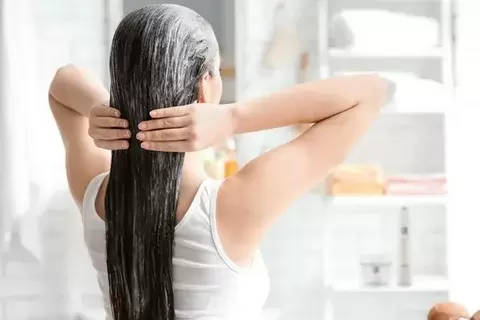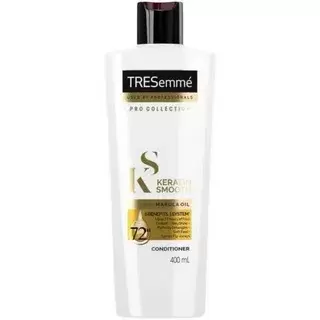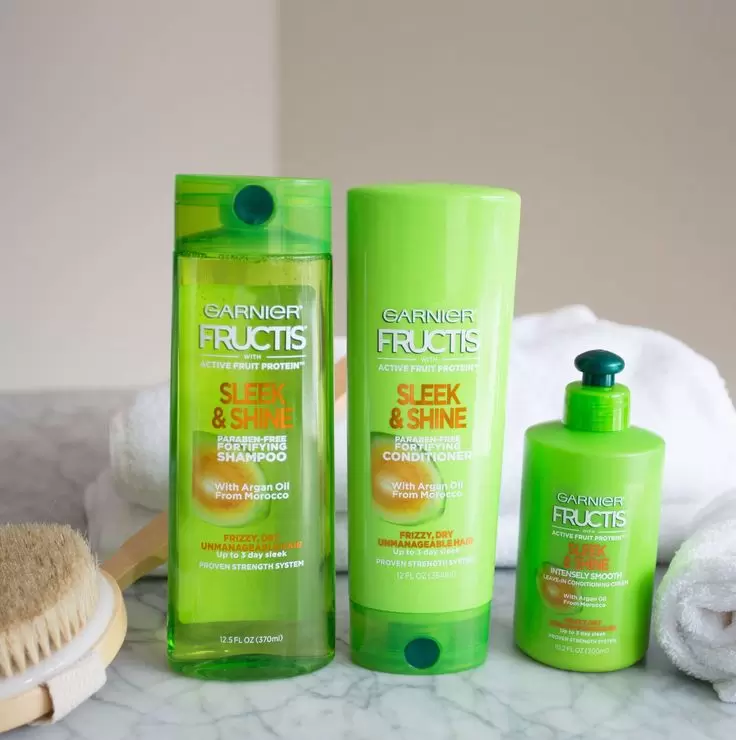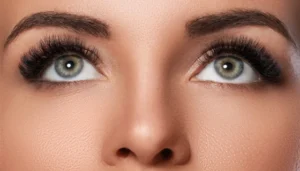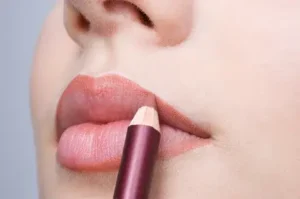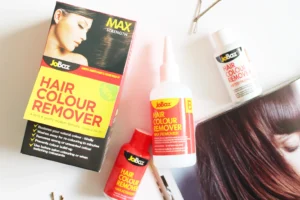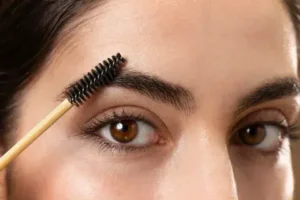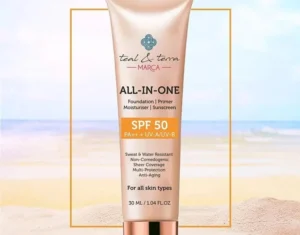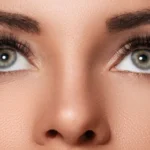Many human beings fear that if the conditioner is not absolutely rinsed from the hair, the residue left in the back of can also dry out strands over time.
This situation stems from the false impression that conditioner acts like a coating on the hair that clogs pores and blocks moisture if no longer washed away. In reality, the truth is more complex.
Conditioning products work to replenish hydration through moisturizing humectants and emollient oils and butters.
When smoothed throughout wet hair post shampoo, these ingredients detangle knots while smoothing down cuticle scales to seal in water.
Properly formulated conditioners are designed to bond with hair fibers without building up as a heavy residue.
While rinsing is still recommended for thicker hair masks that contain more emulsifying ingredients, research has found light conditioner residue alone does not deplete hydration in clean, healthy hairs.
Some think the worry started due to older silicone heavy formulas that did tend to gradually build up on hair over multiple uses.
Modern lightweight conditioners do not contain heavy silicones or polymers that form a visible coating.
Instead, it’s the natural sebum and lipids excreted by the scalp and along the hair shaft itself that maintain hydration balance through their occlusive effect.
If hair cuticles lay flat and the internal structure remains intact, a small amount of light conditioning product bonded into hair can actually help supplement these defenses rather than override them.
As long as hair is regularly cleaned and deep conditioned as needed, minimal light conditioner left in alone will not dehydrate strands.
How Conditioner is Supposed to Moisturize Hair
To understand how leaving a small amount of conditioner in could still keep hair hydrated, it helps to look at how these products are formulated to moisturize in the first place.
The main components that hydrate are humectants and emollients.
Humectants work to attract and bind water molecules to the hair. Common humectants in conditioners include glycerin and hyaluronic acid.
These hydrate by bonding to water in the air as well as water already in the hair. Without rinsing, humectants left on the hair can continually draw in ambient moisture.
Emollient oils and butters also contribute to hair hydration. When applied to wet locks, these work to coat the cuticle layer and seal in water absorbed during conditioning.
Popular emollients include oils like coconut, argan and jojoba. Butters like shea and mango add further moisturizing benefits.
Together, humectants and emollients hydrate hair inside and out when used in light leave in formulations.
Why Some Think Conditioner Leaving Residue Can Dry Hair
In the past, conditioners tended to rely more heavily on thicker polymers like dimethicone and other silicones to detangle hair.
These ingredients did have a reputation for gradually building up residue on the hair shaft with frequent use over many weeks or months.
Modern options have shifted toward more skin identical formulations.
Lightweight conditioners designed for most hair types today contain mild surfactants to properly rinse hair along with lightweight oils, butters and water soluble polymers or proteins that evenly disperse throughout strands without leaving a visible layer.
If anyone does experience product buildup, it’s usually due to oilier scalps and infrequent cleansing rather than light leave in conditioner residue alone.
Keeping hair properly cleaned and exfoliated prevents this issue.
The Truth About Leaving Conditioner in and Hair Hydration
To get a clearer picture of how conditioner residue truly impacts hair moisture levels, scientists have conducted tests comparing fully rinsed vs.
Partially rinsed conditioning treatments. In studies where volunteers left a small amount of light conditioner on hair without rinsing or rinsing 98% of the way, no significant decrease in hydration was measured in clean, healthy hair versus the fully rinsed groups.
Additionally, research using advanced electron microscopy found Light conditioner left lightly bonded into the cuticle does not block the hair’s natural processes.
The hair’s hydrolipid membrane and ability to regulate its own moisture content are not affected.
As long as hair is not weighed down by heavy silicones or product buildup in general conditioning treatments, occasional light leave in residue supplementation does not override hair’s natural hydration defenses.
When Leaving Conditioner In May Actually Be Beneficial
While complete rinsing is still recommended for richer hair masks containing more oils and butters meant for weekly use, leaving a small amount of lightweight daily conditioner in the hair has benefits for some people and hair textures:
Very Dry or Damaged Hair
Strands that are porous damaged or have experienced excessive heat, dye or other processes may gain from sealing cuticles with light conditioning residue on off wash days. The extra hydration can help promote inner hair repair over time.
Coily, Tightly Curled Hair Types
Tight curls and coils often see improved definition, frizz control and stretched time between washes from a light coating of conditioner or leave in product sealed with oil. Rinsing all products out can disrupt curl patterns formed during styling.
Those Who Air Dry Styles After Washing
Leaving a small amount of conditioner or a cream based leave-in product in damp hair makes frizz prone styles like braids, twists or wash n’ gos much easier to manage as they dry.
The conditioning agents tame fly aways and smooth the drying process.
For these hair textures or situations, partial rinsing with very light leave in conditioners is absolutely beneficial compared to rigorously scrubbing every last drop away. A balanced approach is ideal versus absolutes.
Final Tips for Using Conditioner and Protecting Moisture
To maintain healthy hydration regardless of rinsing preferences:
- Heavily oiled hair masks or treatments should always be fully rinsed before styling
- Those worried can rinse 98% then seal ends with a few drops of oil or cream
- Limit heat styling and protect hair from environmental damages as much as possible
- Cleanse scalp weekly or as needed based on oil production to avoid buildup
- Do regular hair treatments or use of moisturizing shampoos and conditioners
- Consider treatment masks containing hydrating ingredients weekly or every 2 weeks
- Evaluate hair porosity levels and choose gentle products for that hair type
- Be gentle during combing and styling to avoid stress or breakage of strands
While preference may dictate fully rinsing or partial rinsing for some, light conditioner residue alone has not been shown through research to dry hair when healthy cuticles, sebum and hydration levels are maintained. A balanced approach tailored to individual needs yields the best results.
Frequently Asked Question (FAQs)
Q: Why does my hair feel more dry after conditioner?
A: More than likely you have not cleansed your hair properly, or you are dealing with a significant amount of product build-up.
Q: Can conditioners cause dryness?
A: If using conditioner regularly and the hair becomes dry, it is due to buildup, very often protein buildup.
Q: Is leave-in conditioner good for everyday use?
A: If you wash your hair every day then you can use a leave-in conditioner every day, but if you wash your hair once or twice a week then you shouldn’t reach for a leave-in conditioner daily.
Q: What happens if you use too much leave-in conditioner?
A: Greasiness and buildup.
Q: What are the side effects of leave-in conditioners?
A: Product buildup.
Conclusion of conditioner:
In conclusion, the idea that leaving conditioner residue in hair causes dryness is a myth for most people with healthy styles.
Modern lightweight conditioners are designed to bond with strands to boost hydration without building up or clogging pores.
Hair’s natural protective lipids and sebum, coupled with the humectant and emollient properties of conditioners, work together to maintain moisture equilibrium.
While full rinsing removes all residue, scientific studies show light leftover conditioner does not strip water from clean hair or override its defenses.
For certain textures, a small conditioning amount can even provide extra benefits.
With clean, undamaged hair and a nourished scalp, conditioners fit for each person’s unique texture can be embraced fully or partially rinsed to suit individual needs and lifestyles.
